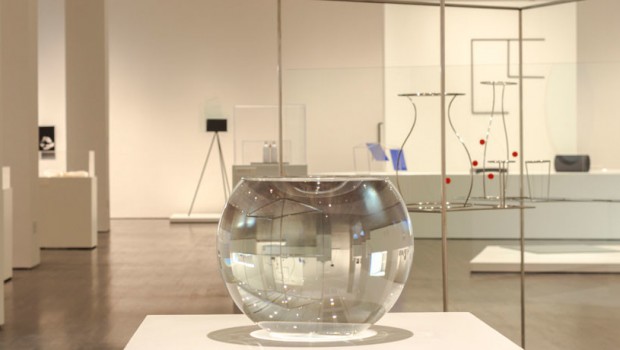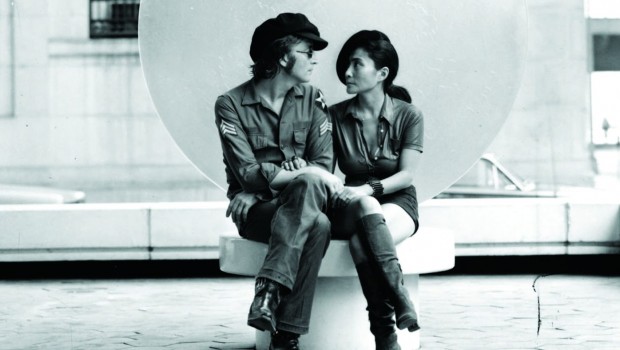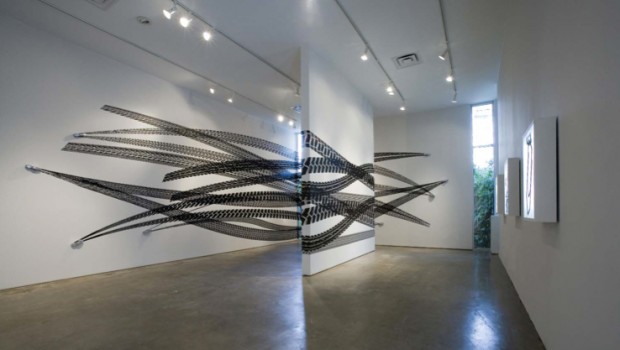Waltercio Caldas at the Blanton Museum
Fernando Castro R.
The Nearest Air: A Survey of Works by Waltercio Caldas at the Blanton Museum of Art in Austin amounts to a small retrospective of the artist’s oeuvre. It is the first solo show in the United States of an artist whose oeuvre has been described as “unclassifiable.” Curated by Gabriel Pérez-Barreiro, the exhibit is comprised of 75 works, many on loan from private collections, some never seen before publicly. In a year in which some countries are voicing disapproval of the idea of loaning their national treasures for exhibits abroad, the Blanton Museum of Art and the Fundação Iberê Camargo have successfully collaborated to organize this exhibition whose first two venues were in Brazil; at the Fundação Iberê Camargo in Porto Alegre, and at the Pinacoteca do Estado de São Paulo.
Two works in the exhibit deserve our first comments because they evidence the aesthetic diversity in the show. Condutores de percepção (1969) is a velvet-covered black case containing two glass rods capped with silver tips. It has the ingredients of a Duchampian readymade: a found object altered for the purpose of art. Guy Brett, a critic quoted in the chronology of the catalogue describes the work thus: “The two conductors lie in their velvet box like the instruments of some fastidious science. They invite touch, they imply investigation, measurement, meaning, and yet they are transparent and void…” Robert Storr, one of the essayists of the book, offers an interpretation which does not differ greatly from Brett’s: “Thus we are left with pseudoscientific or perhaps magical devices that seem to promise exceptional receptivity yet withhold access to it.”
Obviously, both writers have taken “condutores” to be light or electrical conductors, and have not heeded the obvious: that these rods are the batons of hypothetical orchestra conductors. Music and perception, after all, are important leitmotifs in Caldas’ oeuvre. In fact, in the last dozen years or so, Caldas has created works whose sonority is part of their aesthetic offering. Indeed, the two glass wands are not only batons for an imaginary conductor, but themselves potential contain a sound if one were only to risk hitting them as if they were musical claves.
The second Caldas work is the one that gives its name to the exhibit: The Nearest Air (1991). Pérez-Barreiro writes, “Consisting of little more than colored yarn, these works are among Caldas’s largest and most impressive. In them, Caldas uses yarn to carve up space, dividing the air into fractional elements that the audience (sic) must negotiate.” Space is indeed a major concern of Caldas. In a recent interview he expressed, “I think negative space is the biggest space. What we don’t see is a great material. A big material.” So for Caldas the nearest air is not a metaphor, it is the material where his works begin. “I deal with the environment as if it were a sculpture,” he once said. The minimalism of The Nearest Air becomes a maximally occupying presence whose accidental borders are the colored yarn.
Although some of his works like Jazz mirror (2002) and Painted iron rod (1978) might fit seamlessly in an exhibit of concrete art, in many of Caldas’s works figurative representation is indispensable. In fact, Caldas has made Velásquez, painter of painters, the common denominator of his many-sided meditations about the printed artwork, perception, and art-viewing. The Velázquez Book (1996) is an actual book done in offset lithography were the printed paintings are out-of-focus; which curiously enough, was a strategy pictorialistic photographers employed to make their pictures more “painterly.” Mirror for Velásquez (2000) places a small reproduction of Las Meninas in front of a mirror in order to underline and take out of the picture plane the mirror complicit in that famous painting. In Los Velásquez (1994), Caldas removes all the characters in Las Meninas in order to focus solely on the space of the chamber.
Whether his works follow the dictates of Concrete art in not referring to anything but themselves, or comment on the ways of representation and being an art object, Caldas artistic practice seldom fits in traditional categories or isms; and his work does not project itself towards just one, but many visions of art.
Posted: March 9, 2014 at 1:47 am










